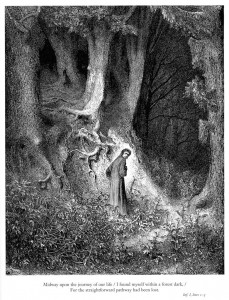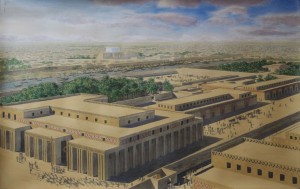Please read Rod Dreher’s piece, How Dante Saved My Life, for the March/April 2014 issue of The American Conservative. It is a beautiful reminder that the works on a canonical reading list are not only politically and philosophically applicable, but are often also spiritually and personally invaluable. For Dreher, Dante Alighieri’s Divina Commedia was a sublime answer to the existential crisis he found himself in last summer. “I never felt the pain of exile as I did last year,” he writes. “A pain exacerbated by my felt inability to steel my mind and marshal my will to master it.”
Just as Virgil leads Dante out of his own jungle of despair and to God, so it was Dante that succeeded in leading Dreher out of the dark, metaphysical labyrinth that he was lost in. The first stanza of the Inferno is already empathetic to a sufferer of a midlife crisis:
Midway in the journey of our life
I came to myself in a dark wood,
For the straight way was lost.
I would like to add that troubled, 46-year-old men are not the only individuals who find personal meaning in these lines. Dante’s Inferno, Purgatorio, and Paradiso, along with the other texts on the Core reading list, also have the potential to provide sacred answers to younger generations of the lost and jaded. Professor Jorgensen’s exalting lecture on the Epic of Gilgamesh, my very first class of college, was a refreshing beacon of spiritual hope for a first-semester freshman who was, like I presume many of my peers also were, ruthlessly flung from the place in which she found value and felt valued for her entire life theretofore. For many of us, post-high school is the first time that we must face the “dark wood” of doubt–doubt in our own futures, abilities, principles, and passions–truly head-on. And for those of us in the Core, our biggest qualms about our own existence are perhaps eased when we explore some of the most time-tested answers to the universal dilemma of human doubt. Perhaps my “Dante” is Gilgamesh; what helped to put me spiritually “back on track”, so to speak, was his concluding decision at the end of a long, fruitless journey filled with grief and peril to seek solace in the graceful unity of nature and human creation:
Study the brickwork, study the fortification;
climb the great ancient stair case to the terrace;
study how it is made, from the terrace see
the planted and fallow fields, the ponds and orchards.
One league is the inner city, another league
is orchards; still another the fields beyond:
over there is the precinct of the temple.
Three leagues and the temple precinct of Ishtar
measure Uruk, the city of Gilgamesh (XI.vi).


